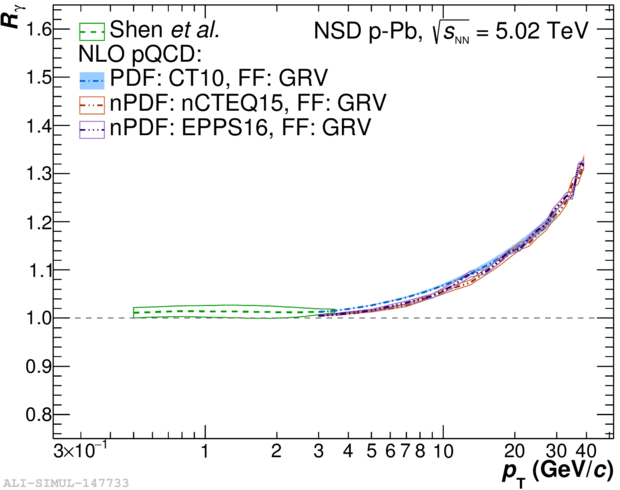Scope: PWG
PWG-GA (Photons, Neutral Mesons)
Energy
5.02 TeV
System
p-Pb
Figure Group
Figure Image

Figure image (.eps)
Figure image (.pdf)
Figure Caption
Theoretically predicted direct photon excess ratio ($R_{\gamma}$ ) using the ALICE decay photon cocktail as denominator for non-single diffractive p–Pb collisions at \sqrt{s_{_{NN}}} = 5.02 TeV. Three different next-to-leading order calculations using different (n)PDFs [2–6] are presented. The latter have been
provided by Werner Vogelsang [1] and Hendrik Poppenborg. Furthermore, they are compared to a recent hydro calculation by Chun Shen et al. [49] at lower transverse momenta.
[1] B. Jager, A. Schafer, M. Stratmann, and W. Vogelsang, “Next-to-leading order QCD corrections to
high p(T) pion production in longitudinally polarized pp collisions”, Phys. Rev. D67 (2003) 054005,
arXiv:hep-ph/0211007.
[2] H.-L. Lai, M. Guzzi, J. Huston, Z. Li, P. M. Nadolsky, J. Pumplin, and C. P. Yuan, “New parton
distributions for collider physics”, Phys. Rev. D82 (2010) 074024, arXiv:1007.2241.
[3] J. Gao, M. Guzzi, J. Huston, H.-L. Lai, Z. Li, P. Nadolsky, J. Pumplin, D. Stump, and C. P. Yuan,
“CT10 next-to-next-to-leading order global analysis of QCD”, Phys. Rev. D89 (2014), no. 3,
033009, arXiv:1302.6246.
[4] M. Guzzi, P. Nadolsky, E. Berger, H.-L. Lai, F. Olness, and C. P. Yuan, “CT10 parton distributions
and other developments in the global QCD analysis”, arXiv:1101.0561.
[5] K. Kovarik et al., “nCTEQ15 - Global analysis of nuclear parton distributions with uncertainties in
the CTEQ framework”, Phys. Rev. D93 (2016), no. 8, 085037, arXiv:1509.00792.
[6] K. J. Eskola, P. Paakkinen, H. Paukkunen, and C. A. Salgado, “EPPS16: Nuclear parton
distributions with LHC data”, Eur. Phys. J. C77 (2017), no. 3, 163, arXiv:1612.05741.
[7] C. Shen, J.-F. Paquet, G. S. Denicol, S. Jeon, and C. Gale, “Collectivity and electromagnetic
radiation in small systems”, Phys. Rev. C95 (2017) 014906, arXiv:1609.02590.
Detail description
Theoretically predicted direct photon excess ratio ($R_{\gamma}$ ) using the ALICE decay photon cocktail as denominator for non-single diffractive p–Pb collisions at \sqrt{s_{_{NN}}} = 5.02 TeV. Three different next-to-leading order calculations using different (n)PDFs [2–6] are presented. The latter have been
provided by Werner Vogelsang [1] and Hendrik Poppenborg. Furthermore, they are compared to a recent hydro calculation by Chun Shen et al. [49] at lower transverse momenta.
[1] B. Jager, A. Schafer, M. Stratmann, and W. Vogelsang, “Next-to-leading order QCD corrections to
high p(T) pion production in longitudinally polarized pp collisions”, Phys. Rev. D67 (2003) 054005,
arXiv:hep-ph/0211007.
[2] H.-L. Lai, M. Guzzi, J. Huston, Z. Li, P. M. Nadolsky, J. Pumplin, and C. P. Yuan, “New parton
distributions for collider physics”, Phys. Rev. D82 (2010) 074024, arXiv:1007.2241.
[3] J. Gao, M. Guzzi, J. Huston, H.-L. Lai, Z. Li, P. Nadolsky, J. Pumplin, D. Stump, and C. P. Yuan,
“CT10 next-to-next-to-leading order global analysis of QCD”, Phys. Rev. D89 (2014), no. 3,
033009, arXiv:1302.6246.
[4] M. Guzzi, P. Nadolsky, E. Berger, H.-L. Lai, F. Olness, and C. P. Yuan, “CT10 parton distributions
and other developments in the global QCD analysis”, arXiv:1101.0561.
[5] K. Kovarik et al., “nCTEQ15 - Global analysis of nuclear parton distributions with uncertainties in
the CTEQ framework”, Phys. Rev. D93 (2016), no. 8, 085037, arXiv:1509.00792.
[6] K. J. Eskola, P. Paakkinen, H. Paukkunen, and C. A. Salgado, “EPPS16: Nuclear parton
distributions with LHC data”, Eur. Phys. J. C77 (2017), no. 3, 163, arXiv:1612.05741.
[7] C. Shen, J.-F. Paquet, G. S. Denicol, S. Jeon, and C. Gale, “Collectivity and electromagnetic
radiation in small systems”, Phys. Rev. C95 (2017) 014906, arXiv:1609.02590.
